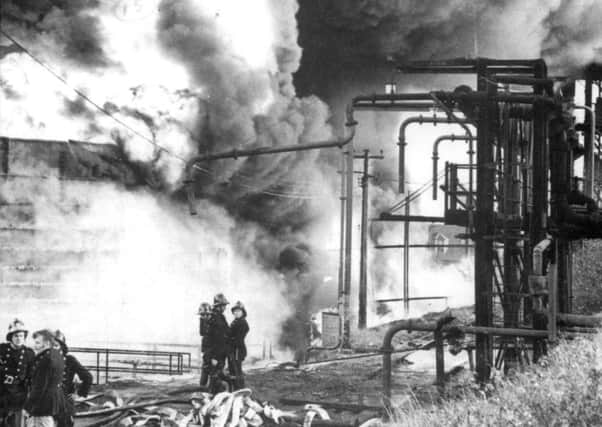Fire blazed for three days at Camelon Tar Works


Like a smoky eclipse of the sun the skies darkened for hours as the biggest fire in the town’s history ripped through the Tar Works in Camelon.
By the time the brave firefighters from all over central Scotland managed to bring it under control several were in hospital, three days had passed, £2 million of damage had been done and one of our oldest and most successful businesses was in near ruins. Though Scottish Tar Distillers did continue to operate on the site it really was the beginning of the end and closure came just a few years later.
Advertisement
Hide AdAdvertisement
Hide AdThe cause of the fire was an explosion in a tanker making a delivery of feedstock from the BP in Grangemouth and the fire quickly spread rupturing creosote pipes and tanks of crude tar which flowed through the works.
Many firefighters including Firemaster Parks, suffered skin contamination and special treatment areas were set up round the site.
At its height on November 6-7 over 100 firefighters were in action and melted tar was pouring unchecked into the Forth and Clyde canal. This prevented the use of canal water in fighting the fire and left a legacy of pollution that took years to rectify. Houses on the north side of the canal were evacuated as a precaution and it was not until late on the third day that the site was declared safe and the emergency at an end.
The origins of the tar distillery date back to the completion of the Union Canal in 1822 which established Camelon as the hub of a new communication system. Soon new inns, workshops, storage facilities and houses appeared along the banks and basins of Port Downie and by 1831 the population was over 800 rising within a decade to 1340.
Advertisement
Hide AdAdvertisement
Hide AdSometime around 1840 two brothers from Airth, James and Andrew Ross, began building boats in a yard near Lock 16. Five years later Andrew was dead and young James, having discovered the value of pitch as a commodity in the boatyard, moved into chemical manufacture at Limewharf just a few hundred yards west of Port Downie.
Crude tar from various gas works was shipped to Camelon where it was converted into naphtha, pitch and refined tar. Business boomed and James Ross directed the expanding company for 30 years until 1878 when Robert Sutherland and Robert Orr assumed control.
New products multiplied – sulphate of ammonia, benzine, creosote, and toluene, a key ingredient in the manufacture of TNT explosives – and prosperity followed. The firm did well during the years of war and the works were refurbished but by 1929 trade was not so healthy and the Lime Wharf Chemical Works became part of Scottish Tar Distillers.
One surviving reminder of James Ross is Wallside House, now a home for the elderly, which he built for himself and which still bears his carved initials.
Advertisement
Hide AdAdvertisement
Hide AdThe Tar Works was the first and the last of the Camelon chemical companies which operated in Port Downie from the mid Victorian period helping to bring prosperity to the village despite the dangerous nature of the work at a time when health and safety for employees was a low priority.
Today the Tar Works site is home to the Falkirk Wheel and the land once covered in boilers, tanks, retorts and stills is now the haunt of tourists from across the world.
They learn a lot about canals and rotating boat lifts but not much about the century or more of industry which is a pity.